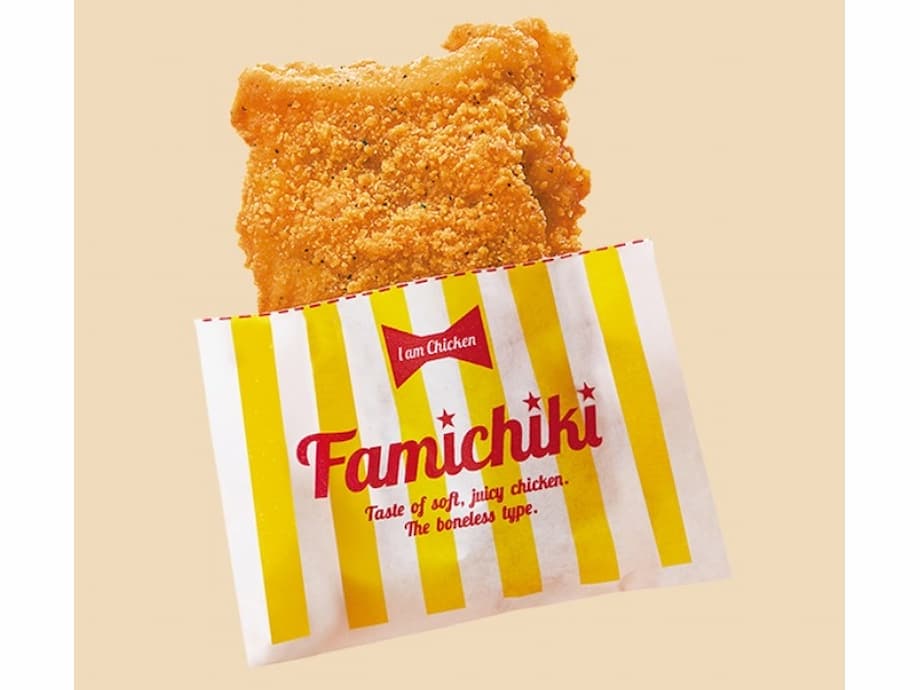A new tabehodai challenge for Famichiki fans
Family Mart is giving its most famous hot snack a spotlight like never before. The chain will host a first ever all you can eat session for Famichiki, the boneless fried chicken that many travelers and locals consider a convenience store classic. The timed format sets a simple challenge. Pay 1,000 yen, take a seat, and eat as much as you like within 30 minutes. Fans can choose between the regular flavor and the punchier Famichiki Red, sip the included bottled water, and even turn the cutlets into quick sandwiches with up to two sets of special buns. A stamp sheet at the table tracks pieces as you go, adding a game like element to the experience.
- A new tabehodai challenge for Famichiki fans
- What you get for 1,000 yen
- Where and when, plus how to reserve
- Value math and how the timed format shapes strategy
- Why Famichiki holds a special place in conbini culture
- How it compares to rival fried chicken at other chains
- AgeAge fried food festival and the merch lottery
- Eat in rules, shrinking counter space, and the tax difference
- All you can eat culture in Japan and why this is rare at a conbini
- At a Glance
The limited event, branded as a dream session for Famichiki lovers, will run on two days only, September 27 and 28 (2025), with two seatings each afternoon at 2 p.m. and 3 p.m. Places are scarce. Each location will host about ten people per seating, and participation requires a reservation made online or at in store ticketing terminals. It is a rare sight for a convenience store to stage a sit down eating challenge, and the short window suggests a pilot meant to test demand and create buzz among conbini regulars.
What you get for 1,000 yen
The session is straightforward by design. Diners select pieces from the hot case in either of two flavors, classic or Red, and can switch between them during the 30 minutes. A bottle of water is included to keep everyone hydrated. Family Mart will also provide up to two sets of soft buns so participants can press the cutlets into quick sandwiches, a popular way to enjoy Famichiki at the counter. Staff will hand out a simple stamp card that records each piece eaten so the tally is clear when time is up. The goal is not a formal contest, just a fun, finite window to enjoy a cult favorite in a shared setting.
There is no separate entry fee or penalty system beyond the flat 1,000 yen ticket. The short time limit encourages quick decision making. Many regular customers already know their preferred flavor and eating pace. The buns are capped at two sets to keep the focus on the chicken. Alcohol is not permitted in store, even at branches with a counter, so pairings will need to happen at home after the session.
Where and when, plus how to reserve
The all you can eat event is not everywhere. It is available at a small group of Family Mart stores spread around the country over one weekend. Reservations open on September 19 at 6 p.m. Japan Standard Time and are first come, first served. Booking can be completed through the company website or at in store ticket machines. The participating branches are listed across nine prefectures.
- Hokkaido, Subway Shindo higashi Station Front
- Miyagi, Sendai Clis Road
- Tokyo, NTT Kanto Medical Center Front
- Kanagawa, Ichizawa cho
- Aichi, Nadia Park Front
- Aichi, Gokiso Station Front
- Hyogo, Former Foreign Settlement East
- Osaka, Taisho Station North
- Fukuoka, Fukudai Engineering Faculty Front
- Fukuoka, Fukuoka Doi 4 chome
Each day has two seatings, 2 p.m. and 3 p.m., and each seating accommodates roughly ten people per store. Given the small capacity and the brand’s nationwide following, expect reservations to go quickly. Those unable to secure a seat can still take part in the concurrent fried food festival that runs for several weeks across the chain.
Value math and how the timed format shapes strategy
Famichiki typically sells for around 240 yen per piece at many stores in 2025, though individual prices can vary by product and location. At a flat ticket of 1,000 yen, the break even point is four to five pieces. Four pieces would total about 960 yen at regular price. A fifth piece would normally push the out of pocket cost above the ticket price. That simple math explains the 30 minute clock and the stamp sheet. It is a playful structure that lets diners test their appetite without turning the event into an endurance feat.
Many fans enjoy Famichiki as a sandwich using the store’s dedicated buns, which come with a slit that fits the cutlet. During the event, buns are limited to two sets, so frequent sandwiching is not the most efficient route if you are chasing piece counts. The included water helps with pace, and flavor switching can keep things interesting over a short sprint. The best approach is personal, since some prefer the spicy Red for a jolt, while others stick to the mellow crunch of the original.
Why Famichiki holds a special place in conbini culture
Famichiki launched in 2006 and grew into a staple at the hot snack case near the register. The cutlet’s appeal is simple. It has a crispy coating, juicy meat, and a spice blend that works as a stand alone snack or a quick sandwich. The packaging is practical too. Staff slide the cutlet into a paper pouch with a tear open top, which keeps fingers clean and makes walking while eating easier. Tourists often discover this in their first days in Japan and make it a habit on train days.
The brand has reached beyond snack culture into community events. Family Mart has tens of thousands of branches nationwide and it has used Famichiki to mark milestones. One recent example was a citywide school lunch day in Sayama, Saitama Prefecture, the company’s original hometown, where public schools received Famichiki as the main dish to celebrate an anniversary. Moments like that show how a convenience store item can become part of daily life in Japan.
How it compares to rival fried chicken at other chains
Japanese convenience stores compete intensely in the fried chicken category. 7 Eleven offers Nana Chiki, a filet seasoned with a blend of herbs and spices. Lawson offers L Chiki and bite size Karaage kun, and has also rolled out new items such as Manmaru Chicken at 248 yen that emphasize a plump, filling cut. Taste tests often land on Famichiki as the benchmark for crunch and juiciness, while Nana Chiki leans into bold seasoning and Lawson’s lineup highlights variety and value.
Price points sit in the same range. Many Nana Chiki pieces list around 220 yen, while Manmaru debuted near 248 yen. Famichiki’s typical ticket is about 240 yen, and limited flavor runs appear through the year. This event stands out because a convenience store chain is inviting fans to sit down and eat together on a timer, which is far more common at buffet restaurants than at a shop best known for grab and go meals.
AgeAge fried food festival and the merch lottery
Family Mart is pairing the weekend event with a longer festival for fried foods, branded the AgeAge period, that runs from September 16 to October 6. Anyone buying Famichiki during that window can join a digital stamp rally through the Fami Pay app. Collect stamps, then enter a lottery for store themed goods. The prize pool features playful items such as Famichiki suitcases, earrings, socks, and pins, along with clothing accessories tied to the fried chicken motif.
The festival also includes coupon style promotions for shoppers who pick up hot snacks. The stamp rally is a proven tactic in Japan for tying everyday purchases to a lighthearted game. It keeps the focus on the item while encouraging repeat visits, and this run adds a slice of novelty through the all you can eat sessions on the middle weekend.
Eat in rules, shrinking counter space, and the tax difference
Many Japanese convenience stores built small eat in corners over the last decade, giving customers a place to sit with coffee or a quick lunch. Family Mart has started to reduce these spaces and convert them back into retail floor, citing changing habits and the need to stock more categories like clothing and daily goods. Some stores still have counters, but far fewer than before 2020. That context matters for a timed session like this because seats are limited and the setup will be curated for the event.
Japan also splits sales tax by where food is consumed. Takeout items are taxed at 8 percent, while eating inside a store draws a 10 percent rate. That two point gap can nudge customers toward takeout. Alcohol rules are straightforward. Drinking inside a convenience store is not allowed, including at branches with counters, so any pairing with beer or highball will have to wait until you are off the premises.
All you can eat culture in Japan and why this is rare at a conbini
Buffets and flat price feasts in Japan go by the term tabehodai. Many sit down restaurants offer timed plans for yakiniku, shabu shabu, sweets buffets, or pizza. A convenience store staging a timed session is unusual. Conbini are built for speed, with tightly managed hot cases, short queues, and a layout designed for people who are in and out in minutes. The Famichiki event bends that model for a weekend to create a shared spectacle and to celebrate a product that drives daily footfall.
If you plan to join, prepare by booking as soon as reservations open, checking the store address carefully, and arriving early for check in. The 30 minute clock is short, but the seating is small and the tone is friendly. It is a chance to compare flavors back to back and see how your personal best stacks up against what you imagined. Those who miss a seat can still pick up a hot cutlet, join the stamp rally, and watch for future sessions if the pilot proves popular.
At a Glance
- Family Mart will host a first ever all you can eat Famichiki session on September 27 and 28, with two seatings at 2 p.m. and 3 p.m.
- Tickets cost 1,000 yen for 30 minutes and include original or Red Famichiki, a bottle of water, and up to two sets of buns.
- Seats are limited to about ten participants per seating at each location and require advance reservation online or at in store terminals.
- Participating branches span ten stores in Hokkaido, Miyagi, Tokyo, Kanagawa, Aichi, Hyogo, Osaka, and Fukuoka.
- Famichiki usually costs about 240 yen per piece, so five pieces would surpass the ticket price at typical shelf rates.
- The AgeAge fried food festival runs from September 16 to October 6 with a Fami Pay stamp rally and a lottery for Famichiki themed goods.
- Alcohol cannot be consumed in store, and eat in counter space is shrinking across the chain as stores add more retail floor.
- Rival conbini chicken options include 7 Eleven’s Nana Chiki and Lawson’s L Chiki and Manmaru Chicken, but Famichiki remains the benchmark for many fans.




